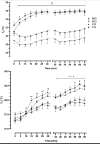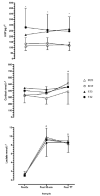Heat shock protein response during fixed intensity and self-paced exercise in the heat in young, healthy women on oral contraceptives compared with young healthy men
- PMID: 36815907
- PMCID: PMC9924522
- DOI: 10.17159/2078-516X/2022/v34i1a11757
Heat shock protein response during fixed intensity and self-paced exercise in the heat in young, healthy women on oral contraceptives compared with young healthy men
Abstract
Background: Heat shock proteins respond to a variety of physiological and environmental stresses, including heat stress, ischemia and endotoxic shock. Hormonal changes during the female menstrual cycle can have a thermogenic effect on body temperature. The monophasic oral contraceptive (OC) pill provides low doses of progesterone and oestrogen over the course of the normal menstrual phase. There is little evidence regarding the combined effects of OC on exercise performance and heat stress with respect to heat shock protein response.
Objectives: This study aimed to determine the response of heat shock proteins (Hsp72) during fixed-intensity and self-paced exercise in the heat in young, healthy women on oral contraceptives compared with young healthy men.
Methods: Sixteen physically active men and women performed 30 min fixed-intensity cycling at 50% of maximum workload, followed by 30 min of a self-paced time trial (TT) interspersed by 30 s maximal sprint at 9, 19 and 29 min respectively. Trials were undertaken in cool (20°C; 48±3% relative humidity (RH)) and warm (32°C; 66±2% RH) ambient conditions. Core (T c) and skin temperature, heart rate (HR) and subjective responses were measured before, during and post exercise.
Results: The distance, mean and peak power output, mean and peak speed during the self-paced time trial showed no difference between the ambient temperatures for men and women. Hsp72 in females was higher than males at all sample points at both 20°C and 32°C, except for pre-exercise at 20°C (p< 0.04). Women also attained a higher T c than men at the end of the TT in the heat (38.5°C v 37.9°C for women and men, respectively; p<0.03), higher mean HR and perceived exertion.
Conclusion: This study indicates that females who use oral contraceptives (OC) had higher levels of Hsp72 than males when tested under the same environmental conditions.
Keywords: Hsp; cellular stress; females; performance; thermoregulation.
Conflict of interest statement
Conflict of interest and source of funding: The authors declare no conflict of interest. This study was supported in part by a CSU postgraduate award to K. Onus.
Figures


Similar articles
-
On exercise thermoregulation in females: interaction of endogenous and exogenous ovarian hormones.J Physiol. 2019 Jan;597(1):71-88. doi: 10.1113/JP276233. Epub 2018 Nov 22. J Physiol. 2019. PMID: 30320879 Free PMC article.
-
Hyperoxia enhances self-paced exercise performance to a greater extent in cool than hot conditions.Exp Physiol. 2019 Sep;104(9):1398-1407. doi: 10.1113/EP087864. Epub 2019 Jul 26. Exp Physiol. 2019. PMID: 31290172
-
Self-paced exercise in hot and cool conditions is associated with the maintenance of %V̇O2peak within a narrow range.J Appl Physiol (1985). 2015 May 15;118(10):1258-65. doi: 10.1152/japplphysiol.00084.2015. Epub 2015 Mar 26. J Appl Physiol (1985). 2015. PMID: 25814635
-
Prolonged self-paced exercise in the heat - environmental factors affecting performance.Temperature (Austin). 2016 Aug 15;3(4):539-548. doi: 10.1080/23328940.2016.1216257. eCollection 2016. Temperature (Austin). 2016. PMID: 28090557 Free PMC article. Review.
-
Heat stress and fetal risk. Environmental limits for exercise and passive heat stress during pregnancy: a systematic review with best evidence synthesis.Br J Sports Med. 2019 Jul;53(13):799-805. doi: 10.1136/bjsports-2017-097914. Epub 2018 Mar 1. Br J Sports Med. 2019. PMID: 29496695
References
LinkOut - more resources
Full Text Sources
